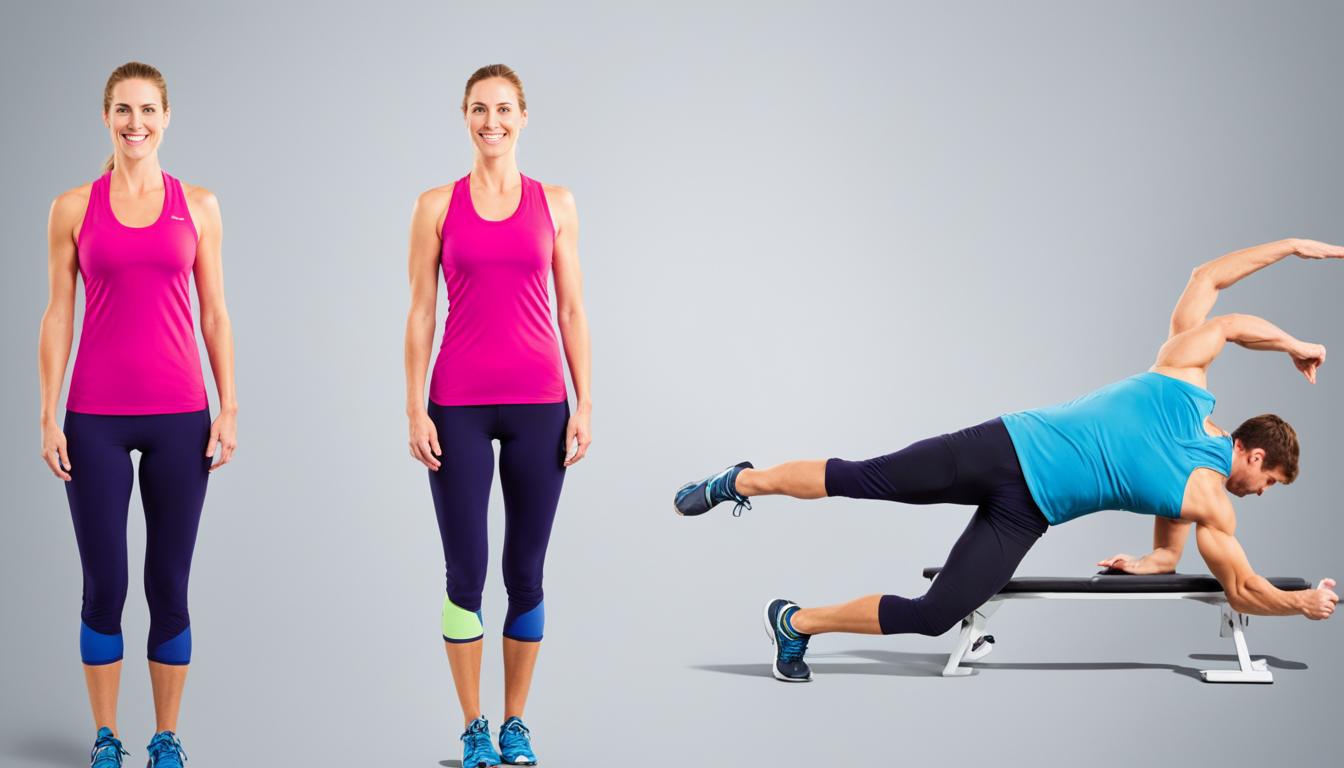Welcome to the world of fitness and lifestyle, where health and wellness go hand in hand with healthy living. Achieving your best self requires a holistic approach that encompasses physical fitness, mental well-being, and overall happiness. In this article, we’ll explore expert tips and insights from top fitness coaches to help you embark on your journey towards a healthier and more fulfilling life.
Whether you’re a seasoned fitness enthusiast or just starting out, incorporating these tips into your daily routine can make a significant difference. From choosing the right sport to prioritizing recovery, we’ve got you covered with actionable advice that will empower you to unleash your full potential.
Key Takeaways:
- Choose a favorite sport that brings you joy and is easily accessible for consistent engagement.
- Warm up properly before each workout to enhance performance and prevent injury.
- Include simple exercises and regular walks throughout the day to stay active and increase overall fitness.
- Listen to your body and avoid pushing yourself beyond the point of pain.
- Prioritize recovery through joint mobility exercises and prioritizing quality sleep for optimal results.
Choose Your Favorite Sport
When it comes to staying fit and active, finding a physical activity that you truly enjoy is the key to a successful fitness routine. Whether it’s the upbeat rhythm of Zumba, the graceful movements of dance, the team spirit of cricket or football, the competitive nature of tennis, or the invigorating rhythm of jogging, there are plenty of options to choose from.
Engaging in a sport or activity that you love not only makes exercising more enjoyable but also increases your likelihood of sticking to your fitness routine. When you’re having fun, it doesn’t feel like a chore, and you’re more likely to make it a regular part of your lifestyle.
According to health organizations, adults should aim for a minimum of 150 minutes of moderate-intensity exercise per week. So whether you’re grooving to your favorite beats in a Zumba class, expressing yourself through dance, chasing the ball in a game of cricket or football, honing your skills on the tennis court, or lacing up your running shoes for a jog, you’re on the right track.
Remember, fitness is not just about burning calories; it’s about leading a healthy and active life. So, choose a sport that brings you joy and fits into your schedule, and let the fun begin!

Find Your Passion and Commit
“I never considered fitness a duty. For me, it was always an outlet for self-expression and a way to stay healthy. Dance allows me to combine both of these passions and brings me immense joy.” – Sarah Anderson, professional dancer.
Proper Warm-up and Cool-down
Before diving into an intense workout, taking the time to properly warm up your body allows for better blood flow, coordination, and overall performance. A well-executed warm-up routine not only prepares your muscles and joints for action but also primes your body for optimal movement.
As you commence your warm-up, focus on gentle movements that gradually increase in intensity. This can include activities such as jogging in place, arm swings, or light aerobic exercises. By doing so, you encourage blood flow to your muscles, ensuring they receive the necessary oxygen and nutrients for optimal function.
Another essential aspect of warming up is incorporating dynamic stretches. Dynamic stretches are active movements that stretch and engage multiple muscle groups simultaneously. They help to improve your range of motion and enhance coordination, both crucial for preventing injuries and promoting efficient movement patterns.
Once you’ve completed your workout, the cool-down phase becomes equally important. Cooling down helps your body transition from an active state to a state of rest, aiding in the elimination of waste products and reducing post-exercise muscle soreness.
During the cool-down, focus on low-intensity exercises such as gentle walking, jogging, or static stretching. This gradual decrease in intensity allows your heart rate and breathing to return to baseline while aiding in the removal of lactic acid and other metabolic byproducts that accumulate during exercise.
Integrating static stretches, where you hold individual muscle stretches for a certain duration, during the cool-down phase can further promote flexibility and assist in muscle recovery. These stretches can target specific muscle groups that were involved in your workout, such as hamstrings, quadriceps, and calves.
Remember, a well-structured warm-up and cool-down routine not only helps prevent injuries but also enhances your overall workout experience. So take the time to adequately prepare your body before and after exercise to optimize your performance and support your long-term fitness goals.

Stay Active Throughout the Day
If you have a sedentary job, it’s important to find ways to stay active throughout the day. Sitting for long periods can negatively impact your health and well-being. Incorporating small activities into your work routine can make a big difference in your overall fitness and productivity.
One effective strategy is to set hourly reminders to stand up, stretch, and do simple exercises. This can include neck rotations, shoulder rolls, or even a quick walk around the office. These movements help improve circulation, reduce stress, and prevent muscle stiffness.
“Taking short walks during your breaks can help enhance circulation, reduce stress, and maintain energy levels.”
When you have a break, instead of staying seated, make the most of it by taking a short walk. Walking not only helps improve circulation but also gives you an opportunity to step away from your desk and clear your mind. This can have a positive impact on your focus and productivity when you return to work.
Remember, it’s the small activities you incorporate throughout the day that add up and make a difference. By staying active and avoiding prolonged periods of sitting, you can improve your overall well-being and reduce the health risks associated with a sedentary job.

Listen to Your Body
When it comes to your fitness journey, it’s crucial to listen to your body and prioritize your well-being. Pushing yourself to the maximum intensity may seem like the best way to achieve results, but the “no pain, no gain” approach can often do more harm than good.
Optimal training is about finding the right balance between challenging yourself and avoiding excessive strain. It’s recommended to reach around 70% of your maximum intensity during workouts. This level allows for effective progress without overtaxing your body, reducing the risk of injuries and burnout.
To make the most of your training session, keeping workouts short and effective is key. Focus on exercises that engage multiple muscle groups and incorporate both strength and cardio elements. Remember, quality over quantity.

“Training is like pulling a rubber band. If you stretch it too far, it will snap. But if you find the right tension, it will propel you forward.”
Following a structured routine is also important. Consider a 3:1 training schedule, with three days of focused workouts and one day dedicated to indulgence and active recovery. This balance allows your body to adapt and recover, promoting better long-term progress and preventing plateaus.
Before embarking on any fitness program, it’s advisable to consult a health professional for a fitness test. This assessment will help gauge your current fitness level and provide insights into areas of improvement. Armed with this knowledge, you can plan your fitness journey with precision and set realistic goals for optimal results.
Remember, recovery is just as important as training itself. Adequate recovery allows your body to repair and rebuild, leading to improved performance and muscle growth. Focus on activities that promote joint mobility and flexibility, such as yoga or foam rolling. Additionally, prioritize quality sleep to enhance the recovery process and optimize overall well-being.
Prioritize Recovery
Recovery is a vital but often overlooked aspect of physical fitness. It plays a crucial role in achieving optimal results and preventing injuries. To support your fitness journey, it is essential to prioritize joint mobility and quality sleep.
Joint mobility exercises should be incorporated alongside your regular workout routine. These exercises improve flexibility, enhance range of motion, and reduce the risk of joint-related injuries. By maintaining healthy joints, you can maximize your physical performance and enjoy the benefits of a well-rounded fitness regimen.
Quality sleep is equally important for proper recovery. During sleep, your body repairs and replenishes itself. It promotes the production of growth hormones, facilitates protein synthesis, and boosts immune system function. Aim for 7 to 9 hours of uninterrupted sleep each night to accelerate healing and optimize overall performance.
FAQ
How can I incorporate fitness into my lifestyle?
Choosing a favorite sport that is fun and accessible is a great way to engage consistently. Additionally, staying active throughout the day by incorporating simple exercises and taking regular walks can make a big difference.
What is the importance of warming up and cooling down?
Proper warm-up and cool-down routines are essential for enhancing performance and preventing injury. They promote blood flow, metabolic reactions, coordination, and help flush out metabolic byproducts and prevent stiffness.
How can I stay active if I have a sedentary job?
Set hourly reminders to stand up, stretch, and do simple exercises like neck rotations and shoulder rolls. Taking short walks during breaks can also enhance circulation, reduce stress, and maintain energy levels.
What should I keep in mind while working out?
It is important to listen to your body and avoid pushing to the point of pain. Optimal training involves reaching around 70% of your maximum intensity. Consulting a health professional for a fitness test can help gauge your current fitness level and plan your fitness journey accordingly.
How can I prioritize recovery in my fitness routine?
Prioritizing joint mobility alongside regular exercise can enhance flexibility and prevent injuries. Quality sleep, aiming for 7 to 9 hours nightly, is also important for proper recovery, as it helps with growth hormone production, protein synthesis, and immune system strengthening.
Source Links
- https://uptothebeat.com/start-here-to-unlock-your-best-self/
- https://www.deccanchronicle.com/lifestyle/health-and-well-being/unlock-your-best-self-881990
- https://medium.com/@hafizakram77377/unlock-your-best-self-a-comprehensive-guide-to-optimal-health-and-a7f26f3dbcc4


